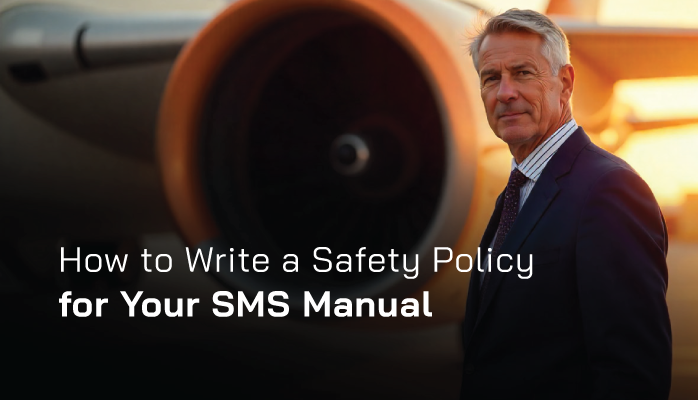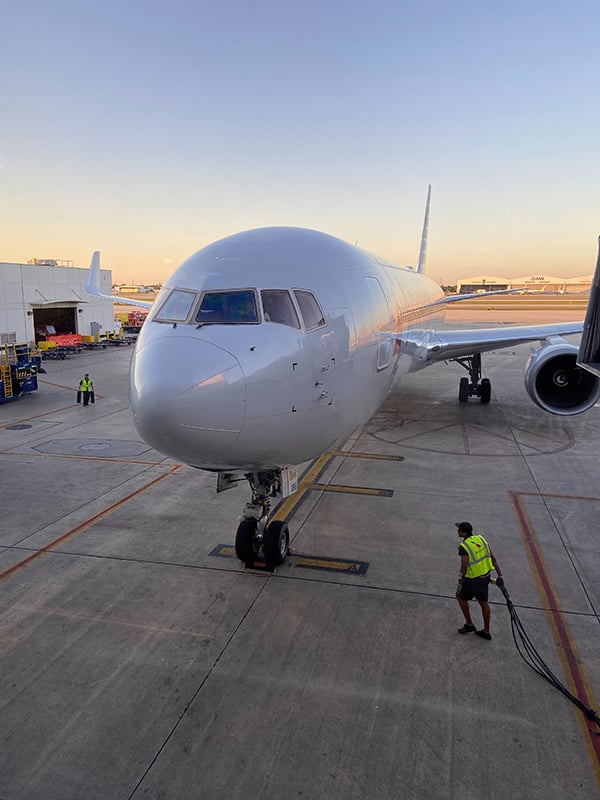Writing Safety Policy for SMS Manual

A safety policy statement is the cornerstone of an aviation Safety Management System (SMS) manual, setting the tone for an organization’s commitment to safety.
Required under ICAO Annex 19 and FAA Part 5 (TOC 1.3), it outlines the organization’s safety objectives, non-punitive reporting principles, and fatigue management strategies (TOC 1.3.3–1.3.5).
For safety managers, consultants, and accountable executives, crafting a clear and compliant safety policy is critical to achieving regulatory compliance and fostering a proactive safety culture. This guide provides a step-by-step approach to writing an ICAO-compliant safety policy, leveraging tools to ensure leadership buy-in, which is essential for 95% of successful SMS implementations, as seen in client outcomes.
Step 1: Define the Purpose of the Safety Policy
The safety policy articulates the organization’s dedication to managing safety risks, aligning with standards outlined in ICAO Doc 9859. It serves as a public commitment from the accountable executive to prioritize safety over operational pressures, whether for a small flight school or a global airline. According to SKYbrary’s SMS framework, the policy must be clear, concise, and accessible to all employees, ensuring it resonates with frontline staff and leadership alike.
Begin by reviewing regulatory requirements, such as FAA Advisory Circular 120-92B, which emphasizes the need for a signed policy statement. Use resources like What is a Safety Policy to understand key components, including accountability, employee involvement, and continuous improvement. This step helps new safety managers at fixed-base operators (FBOs) or experienced professionals at airports set a solid foundation.
Key actions:
- Study ICAO, FAA, or EASA guidelines to identify mandatory policy elements.
- Engage the accountable executive to align the policy with organizational goals.
- Ensure the policy is written in plain language for universal understanding.
Step 2: Craft a Non-Punitive Reporting Policy

A non-punitive reporting policy (TOC 1.3.4) encourages employees to report hazards without fear of reprisal, a critical factor in boosting reporting engagement by 50%, as evidenced by client data. This policy must explicitly state that employees will not face disciplinary action for reporting unintentional errors, except in cases of gross negligence or willful misconduct. For practical guidance, refer to How to Write a Non-Punitive Reporting Policy, which offers templates tailored to FAA and EASA standards.
Include procedures for submitting reports, such as through a confidential reporting system, and outline how reports will be processed. For example, a Part 135 operator might use a web-based hazard reporting tool to streamline submissions. The Confidential Safety Reporting System provides a framework for ensuring anonymity, which is vital for small operators and large airlines alike.
Key actions:
- Draft a statement guaranteeing non-punitive reporting for unintentional errors.
- Specify reporting channels, such as online forms, smart-phone apps or email systems.
- Train employees on the policy to build trust and increase participation.
Step 3: Address Fatigue Risk Management
Fatigue risk management (TOC 1.3.5) is a key component of the safety policy, particularly for operations with high crew workloads, such as medical transport or commercial airlines. The policy should outline strategies to mitigate fatigue-related risks, including rest periods, duty time limits, and employee training on fatigue awareness. For detailed strategies, see Integrating Fatigue Risk Management Systems, which highlights best practices for compliance.
Align the fatigue policy with regulatory standards, such as EASA’s fatigue management rules or FAA’s flight and duty time regulations. For example, a helicopter operator might implement a fatigue risk assessment tool to monitor crew schedules. Consultants supporting maintenance, repair, and overhaul (MRO) organizations can use templates to standardize fatigue policies, ensuring scalability across diverse operations.
Key actions:
- Define fatigue mitigation measures, such as maximum duty hours.
- Integrate fatigue risk assessments into operational planning.
- Document training requirements for fatigue awareness.
Step 4: Secure Leadership Commitment
Leadership buy-in is essential for a safety policy’s success, as the accountable executive must sign and actively support it. Without this commitment, SMS implementations often fail, as noted in 95% of successful cases. The policy should reflect the organization’s values and be endorsed through visible actions, such as allocating resources for safety training, attending safety meetings or auditing. The Accountable Executive resource clarifies the executive’s role in driving SMS compliance.
Engage leadership by presenting a business case that highlights the return on investment (ROI), such as reduced incident costs or improved audit outcomes. For instance, a large operator achieved zero audit findings by prioritizing leadership involvement in policy development. Communicate the policy to all employees through an all-employee letter or safety meetings to reinforce its importance.
Key actions:
- Obtain the accountable executive’s signature on the policy.
- Develop a communication plan to share the policy with staff, such as SMS Pro's read and sign Message Board.
- Monitor leadership’s ongoing support through regular safety reviews.
Step 5: Integrate and Monitor the Policy

Once drafted, integrate the safety policy into the SMS manual and ensure it is accessible to all employees, either digitally or in print. Use tools like the Policies & Procedures Manager module to store and update the policy, ensuring version control. Regularly review the policy during internal audits to verify compliance with FAA, EASA, or ICAO standards. For audit best practices, see How to Conduct Internal SMS Audits.
Monitor the policy’s effectiveness through key performance indicators (KPIs), such as the number of hazard reports submitted or employee participation in safety training. A client airline improved its safety culture by 20% by tracking these metrics in SMS Pro's Safety Goals & Objectives module. Update the policy as needed to reflect regulatory changes or operational shifts, ensuring it remains relevant and effective.
Key actions:
- Distribute the policy to all employees and stakeholders.
- Conduct annual reviews to ensure regulatory compliance.
- Use KPIs to measure the policy’s impact on safety performance.
Common Challenges and Solutions
Safety managers often encounter obstacles when developing a safety policy, such as resistance from leadership or unclear regulatory requirements. Address these challenges:
- Lack of Clarity: Use templates to ensure all required elements are included.
- Employee Skepticism: Promote the non-punitive reporting policy through training.
- Regulatory Complexity: Consult resources like ICAO Doc 9859 for guidance.
By addressing these issues, organizations can create a robust safety policy that supports compliance and safety culture, as demonstrated by clients who reduced compliance risks by 15% through structured policy development.
Conclusion and Call to Action
A well-crafted safety policy is essential for an effective SMS, providing a clear framework for safety management. By defining its purpose, incorporating non-punitive reporting and fatigue management, securing leadership commitment, and monitoring its impact, safety professionals can ensure compliance with FAA, EASA, and ICAO standards. Tools like SMS Pro’s Policies & Procedures Manager and templates simplify the process, making it accessible for operators of all sizes.
Start building your safety policy today. Download free templates from Audit Resources or explore SMS Pro’s solutions at asms-pro.com to streamline your SMS manual development. Take the first step toward a stronger safety culture now.





